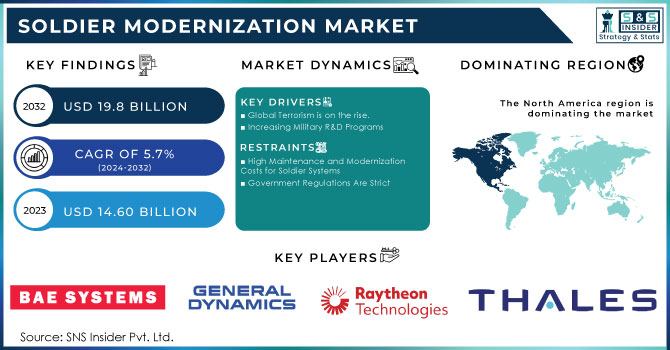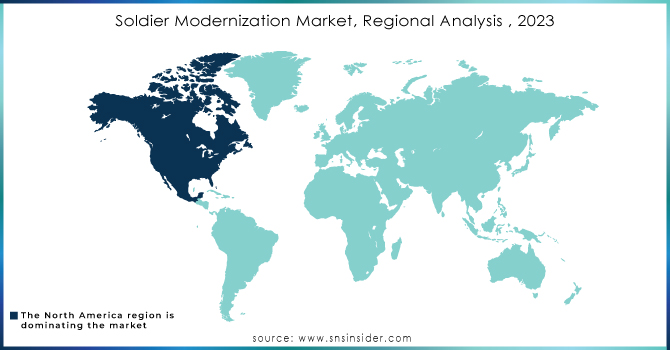Soldier Modernization Market Report Scope & Overview:

To get more information on Soldier Modernization Market - Request Free Sample Report
The Soldier Modernization Market Size was valued at USD 14.60 billion in 2023 and is expected to reach USD 19.8 billion by 2032, growing at a CAGR of 5.7% from 2024-2032.
The growing concern for the safety and security of soldiers around the world has resulted in the expansion of the Soldier Modernization Market. The market is concerned about enhanced and advanced equipment, as well as modernization strategies that can aid soldiers in military tasks. The public and government's need to safeguard front line employees such as troops and armies who protect nations throughout the world has increased the Market Value.
Soldier modernization systems include improved weapons, military vehicles, necessary supplies, and other critical objects used in conflicts and attacks. These upgraded systems are beneficial to all military platforms, including the terrestrial army, navy, and air force. To meet the demand of the defence sectors, significant actors all around the world are contributing to more advanced featured systems. Terrorist attacks, wars, violence, and conflicts are driving the Soldier Modernization Market to develop new technologies, which will result in the development of advanced systems.
MARKET DYNAMICS
KEY DRIVERS
-
Global Terrorism is on the rise.
-
Increasing Military R&D Programs
RESTRAINTS
-
High Maintenance and Modernization Costs for Soldier Systems
-
Government Regulations Are Strict
OPPORTUNITY
-
The increased awareness of the need to protect soldiers boosts the Soldier Modernization Market Trends.
CHALLENGES
-
The market is occasionally challenged by a lack of modern items and systems.
IMPACT OF COVID-19
During the epidemic, the military-based markets experienced varied results. When the manufacturing units were closed, the Soldier Modernization Market suffered. When the supply of raw materials was halted and the delivery process was delayed as a result of the lockdown instructions, the market suffered. Military equipment, materials, and weaponry were even delayed in transit to military agencies. All of these issues contributed to massive economic losses. However, the increased worry about military force protection will assist the industry steady its growth in the coming years. Large investments in the defence sectors boost the Market to a high CAGR value.
The evolving warfare circumstances need militaries to provide soldiers with improved technologies that assist them in adapting to the changes. Soldier systems must meet five key functional requirements: lethality, survivability, command and control, sustainment, and mobility on the battlefield. In this regard, countries are investing in the research and development of sophisticated soldier systems in order to improve their battlefield performance, acquire a tactical edge, and reduce overall unit losses. The topics covered vary from lethality and protection to mobility, command and control (C2) technology, communication, support, and search and rescue systems in a variety of land, airborne, and maritime scenarios.
The Soldier Modernization Market's purpose section is divided into sub-segments such as weaponry/ammunition, C5ISR, protection, and mobility. Weaponry/ammunition has dominated the market in recent years. This market is developing as a result of the increasing demand for updating outdated systems and the increased demand for innovative military equipment such as wearables and sensors in the military sectors.
The C5ISR segment will experience the highest CAGR value due to increased use in military operations, particularly border protection. The protection segment will be driven by an increase in demand for sophisticated ammunition to protect military personnel. Furthermore, the mobile segment will increase steadily as the requirement for swift transit facilities to convey resources to military troops accelerates the segment. The platform section of the Soldier Modernization Market is divided into three categories: airborne, naval, and land.
The airborne segment will have the highest CAGR due to increased investment in aircraft modernization by nations such as China and India. The demand for naval ship modernization by the UK Royal Navy will boost the naval section of the market. Furthermore, the land segment is regarded as the dominant segment, accounting for the largest proportion of the Soldier Modernization Market Share, owing to the increasing need for increased security and lightweight military equipment.
KEY MARKET SEGMENTATION
By Purpose
-
Weaponry or Ammunition
-
Protection
-
Mobility
By Platform
-
Airborne
-
Naval
-
Land
REGIONAL ANALYSIS
The North American area is experiencing the fastest growth rate and the greatest share value of the Soldier Modernization Market Share, and it is regarded as the dominant region due to the presence of key players. The growing collaboration rate among significant European corporations is propelling the European market.
Increased military spending and conflicts in the Asia Pacific region are hastening the region. Furthermore, the rising demand for modernising aircraft in the Middle East and Africa, as well as the increased pace of buying advanced military equipment in Latin America, are pushing regional markets in these countries.

Need any customization research on Soldier Modernization Market - Enquiry Now
REGIONAL COVERAGE:
-
North America
-
USA
-
Canada
-
Mexico
-
-
Europe
-
Germany
-
UK
-
France
-
Italy
-
Spain
-
The Netherlands
-
Rest of Europe
-
-
Asia-Pacific
-
Japan
-
south Korea
-
China
-
India
-
Australia
-
Rest of Asia-Pacific
-
-
The Middle East & Africa
-
Israel
-
UAE
-
South Africa
-
Rest of Middle East & Africa
-
-
Latin America
-
Brazil
-
Argentina
-
Rest of Latin America
-
KEY PLAYERS
The Major Players are BAE Systems, General Dynamics Corporation, Safran Group, Raytheon Company, Elbit Systems Ltd, Ceradyne, Rheinmetall Defense, Thales Group, FLIR Systems Inc, Harris Corporation, and other players
| Report Attributes | Details |
|---|---|
| Market Size in 2022 | USD 14.60 Billion |
| Market Size by 2030 | USD 19.8 Billion |
| CAGR | CAGR of 5.7% From 2024 to 2032 |
| Base Year | 2023 |
| Forecast Period | 2024-2032 |
| Historical Data | 2020-2022 |
| Report Scope & Coverage | Market Size, Segments Analysis, Competitive Landscape, Regional Analysis, DROC & SWOT Analysis, Forecast Outlook |
| Key Segments | • By Platform (Airborne, Naval and Land) • By Purpose (Weaponry/Ammunition, C5ISR, Protection, and Mobility) |
| Regional Analysis/Coverage | North America (USA, Canada, Mexico), Europe (Germany, UK, France, Italy, Spain, Netherlands, Rest of Europe), Asia-Pacific (Japan, South Korea, China, India, Australia, Rest of Asia-Pacific), The Middle East & Africa (Israel, UAE, South Africa, Rest of Middle East & Africa), Latin America (Brazil, Argentina, Rest of Latin America) |
| Company Profiles | BAE Systems, General Dynamics Corporation, Safran Group, Raytheon Company, Elbit Systems Ltd, Ceradyne, Rheinmetall Defense, Thales Group, FLIR Systems Inc, Harris Corporation, and other players. |
| DRIVERS | • Global Terrorism is on the rise. • Increasing Military R&D Programs |
| RESTRAINTS | • High Maintenance and Modernization Costs for Soldier Systems • Government Regulations Are Strict |

